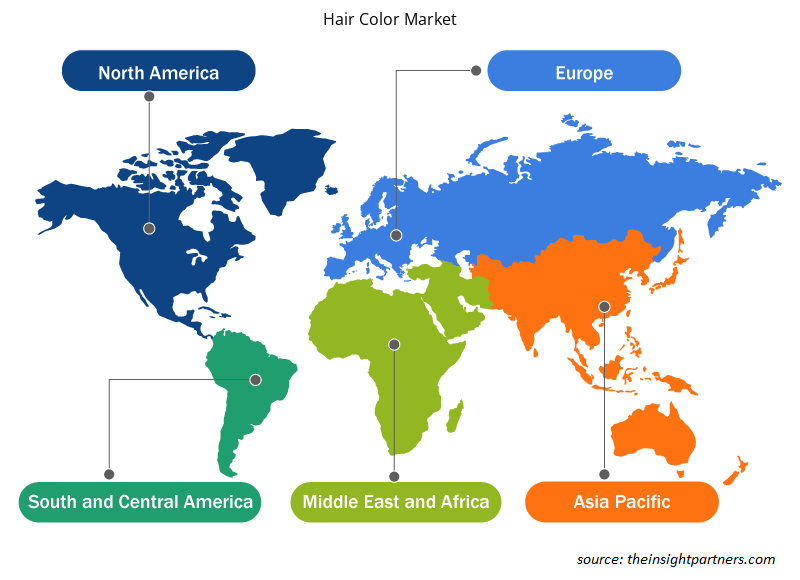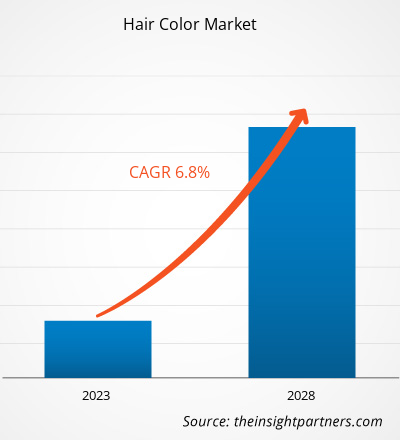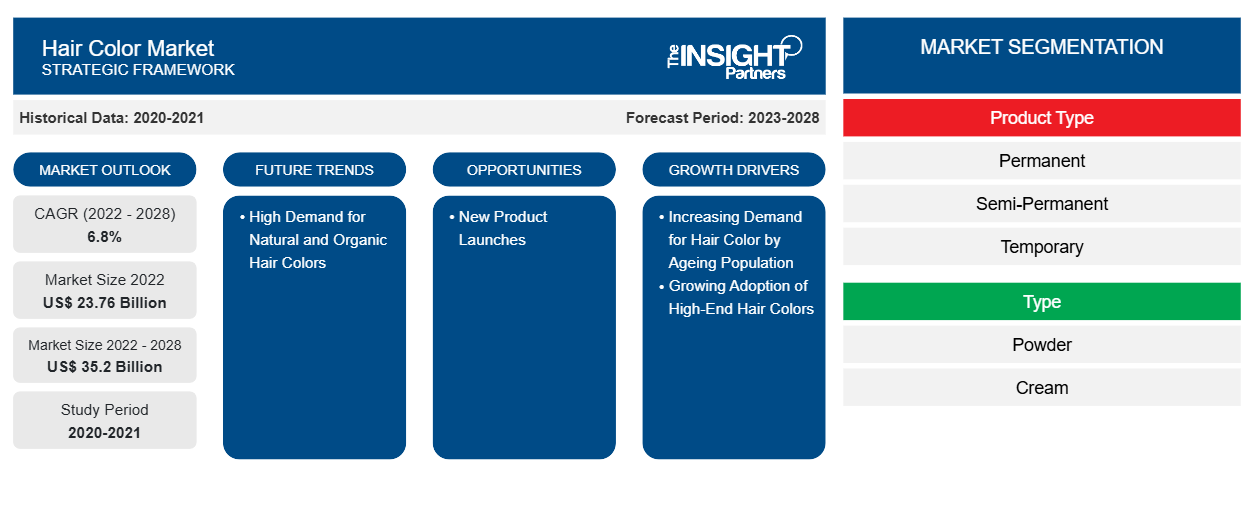[Rapporto di ricerca] Si prevede che il mercato delle tinte per capelli crescerà da 23.762,28 milioni di dollari nel 2022 a 35.201,69 milioni di dollari entro il 2028; si stima che crescerà a un CAGR del 6,8% dal 2022 al 2028.
Il rapporto evidenzia i fattori chiave che guidano il mercato e i principali attori, insieme ai loro sviluppi sul mercato.
Approfondimenti di mercato e opinioni degli analisti:
I colori per capelli sono tinture per capelli che vengono applicate per coprire i capelli grigi o per cambiare il colore naturale dei capelli. Esistono fondamentalmente 3 tipi di colori per capelli: permanenti, semipermanenti e temporanei. I colori per capelli permanenti cambiano in modo permanente il colore naturale dei capelli e solitamente danno i risultati migliori. I colori per capelli sono disponibili in varie tonalità di colore come nero, marrone e bordeaux. I consumatori sono molto preoccupati per il loro aspetto, il che sta creando una domanda significativa di prodotti per la cura personale. Questo fattore sta guidando il mercato dei colori per capelli . Inoltre, anche l'invecchiamento della popolazione è uno dei principali fattori che guidano la domanda di colori e tinture per capelli.
Fattori di crescita e sfide:
La crescente domanda di colore per capelli da parte della popolazione anziana sta guidando la crescita del mercato delle tinte per capelli. Secondo la World Population Ageing Review del 2019, ci sono più di 703 milioni di persone di età pari o superiore a 65 anni nel mondo. La popolazione mondiale sta invecchiando rapidamente a causa del calo dei tassi di fertilità e dell'aumento della longevità o aspettativa di vita. La popolazione anziana utilizza ampiamente il colore per capelli per coprire i capelli grigi . Questo fattore sta guidando in modo significativo la domanda di colore per capelli. Inoltre, a causa dei cambiamenti nello stile di vita e delle carenze nutrizionali, c'è un tasso crescente di ingrigimento precoce . Le persone stanno assistendo all'ingrigimento precoce dei capelli a causa dello stress quotidiano, delle cattive abitudini alimentari, del fumo e di alcune condizioni mediche. Si prevede inoltre che questo fattore aumenterà la domanda di colori per capelli, guidando la crescita del mercato delle tinte per capelli.
Personalizza questo report in base alle tue esigenze
Riceverai la personalizzazione gratuita di qualsiasi report, comprese parti di questo report, o analisi a livello nazionale, pacchetto dati Excel, oltre a usufruire di grandi offerte e sconti per start-up e università
-
Scopri le principali tendenze di mercato in questo rapporto.Questo campione GRATUITO includerà analisi di dati che spaziano dalle tendenze di mercato alle stime e alle previsioni.
Segmentazione e ambito del report:
Il "mercato globale delle colorazioni per capelli" è segmentato in base al tipo di prodotto, al tipo, al canale di distribuzione e all'area geografica.In base al tipo di prodotto, il mercato delle tinte per capelli è suddiviso in permanenti, semipermanenti e temporanei.In base al tipo, il mercato delle tinte per capelli è segmentato in polvere, crema e altri. In base ai canali di distribuzione, il mercato delle tinte per capelli è segmentato in supermercati e ipermercati, negozi specializzati, vendita al dettaglio online e altri. Il mercato delle tinte per capelli in base alla geografia è segmentato in Nord America (Stati Uniti, Canada e Messico), Europa (Germania, Francia, Italia, Regno Unito, Russia e resto d'Europa), Asia Pacifico (Australia, Cina, Giappone, India, Corea del Sud e resto dell'Asia Pacifico), Medio Oriente e Africa (Sudafrica, Arabia Saudita, Emirati Arabi Uniti e resto del Medio Oriente e Africa) e Sud e Centro America (Brasile, Argentina e resto del Sud e Centro America)
Analisi segmentale :
In base ai canali di distribuzione, il mercato delle tinte per capelli è segmentato in supermercati e ipermercati, negozi specializzati, vendita al dettaglio online e altri. Il segmento dei supermercati e degli ipermercati detiene una quota significativa del mercato delle tinte per capelli e si prevede che il segmento della vendita al dettaglio online registrerà una crescita significativa nel periodo di previsione. I supermercati e gli ipermercati sono grandi esercizi commerciali al dettaglio che immagazzinano una varietà di prodotti di marchi locali e premium a prezzi accessibili. Inoltre, questi negozi hanno personale qualificato che aiuta a trovare i prodotti in base alle esigenze del cliente. Inoltre, questi negozi hanno sezioni separate di cosmetici e prodotti per la cura della persona che aiutano i clienti a fare acquisti in modo comodo e senza problemi. Questi fattori stanno guidando le vendite di prodotti per la colorazione dei capelli attraverso supermercati e ipermercati.
In base al tipo, il mercato delle tinte per capelli è segmentato in polvere, crema e altri. Nel 2022, il segmento in polvere ha detenuto la quota di mercato maggiore. Un gran numero di consumatori preferisce le tinte per capelli in crema per la loro facilità di applicazione. Inoltre, contengono ingredienti idratanti che rendono i capelli morbidi e aggiungono lucentezza ai capelli. Questi fattori stanno guidando in modo significativo la crescita del segmento.
Analisi regionale:
In base alla geografia, il mercato delle tinte per capelli è suddiviso in cinque regioni chiave: Nord America, Europa, Asia Pacifico, Sud e Centro America e Medio Oriente e Africa. Il mercato globale delle tinte per capelli è stato dominato dall'Asia Pacifico che ha rappresentato 7.741,75 milioni di dollari nel 2022. Il Nord America è un secondo importante contributore con una quota di mercato superiore al 26% nel mercato globale. L'industria cosmetica nell'Asia Pacifico è in crescita, con una crescente domanda di prodotti premium e un aumento del numero di donne lavoratrici. Inoltre, l'invecchiamento della popolazione nella regione sta ulteriormente contribuendo alla crescita del mercato delle tinte per capelli. Secondo l'Organizzazione mondiale della sanità (OMS), la Cina ha una delle popolazioni anziane in più rapida crescita al mondo. Si prevede che la popolazione di persone con più di 60 anni in Cina raggiungerà il 28% entro il 2040, a causa della maggiore aspettativa di vita e del calo dei tassi di fertilità. Pertanto, si prevede che la crescente domanda di cura della persona, unita al crescente numero di donne lavoratrici e all'invecchiamento della popolazione, guiderà la crescita del mercato delle tinte per capelli nell'Asia Pacifico.
Sviluppi del settore e opportunità future:
Di seguito sono elencate le varie iniziative intraprese dai principali attori operanti nel mercato delle colorazioni per capelli:
- Nel 2022, The Arctic Fox ha lanciato un nuovo colore per capelli, Space Cowgirl, che è colori vivaci con toni verdi o toni pesca. Questo nuovo prodotto può essere miscelato con Aquamarine, Poseidon, Neon Moon, Frose o Periwinkle, in distinte proporzioni come fornito dall'azienda, per ottenere diverse tonalità di colore per i capelli.Frose, or Periwinkle, in distinct ration as provided by the company, to get different color shades to hair.
- Nel 2022, PZ Cussons ha annunciato l'acquisizione di Childs Farm, il marchio leader di mercato nella cura della persona per neonati e bambini nel Regno Unito con una quota del 15% nella categoria. Le linee di prodotti includono bagno e doccia, cura della pelle e cura dei capelli e sono tutte ancorate a una proposta naturale e adatte alle pelli sensibili.PZ Cussons announced the acquisition of Childs Farm, the market-leading brand in UK baby and child personal care with a 15% share of the category. Product lines include bath and shower, skincare, and haircare, and are all anchored in a natural proposition and suitable for sensitive skin.
- Nel 2022, L'Oréal SA ha annunciato il lancio di Colorsonic, progettato per i consumatori, e delle tecnologie Coloright, progettate per gli stilisti. L'azienda ha lavorato con 400 clienti per sviluppare i prodotti Colorsonic. Il prodotto contiene una cartuccia di colore (40 colori), un miscelatore (combina il colore e sviluppa per il cliente) e un applicatore a pettine. Inoltre, la tecnologia Coloright è focalizzata sulla creazione di coerenza e sull'aggiunta di approfondimenti sui dati nel processo di colorazione.L’Oréal S.A announced the launch of Colorsonic, designed for consumers, and Coloright technologies, designed for stylists. The company worked with 400 customers to develop Colorsonic products. The product contains a color cartridge (40 colors), a mixer (combines the color and develops for the customer), and a comb applicator. Moreover, the Coloright technology is focused on creating consistency and adding data insights in coloring process.
Approfondimenti regionali sul mercato dei colori per capelli
Le tendenze regionali e i fattori che influenzano il mercato delle tinte per capelli durante il periodo di previsione sono stati ampiamente spiegati dagli analisti di Insight Partners. Questa sezione discute anche i segmenti e la geografia del mercato delle tinte per capelli in Nord America, Europa, Asia Pacifico, Medio Oriente e Africa, e Sud e Centro America.

- Ottieni i dati specifici regionali per il mercato delle tinte per capelli
Ambito del rapporto sul mercato dei colori per capelli
| Attributo del report | Dettagli |
|---|---|
| Dimensioni del mercato nel 2022 | 23,76 miliardi di dollari USA |
| Dimensioni del mercato entro il 2028 | 35,2 miliardi di dollari USA |
| CAGR globale (2022 - 2028) | 6,8% |
| Dati storici | 2020-2021 |
| Periodo di previsione | 2023-2028 |
| Segmenti coperti |
Per tipo di prodotto
|
| Regioni e Paesi coperti |
America del Nord
|
| Leader di mercato e profili aziendali chiave |
|
Densità dei giocatori del mercato della colorazione dei capelli: comprendere il suo impatto sulle dinamiche aziendali
Il mercato del colore dei capelli sta crescendo rapidamente, spinto dalla crescente domanda degli utenti finali dovuta a fattori quali l'evoluzione delle preferenze dei consumatori, i progressi tecnologici e una maggiore consapevolezza dei benefici del prodotto. Con l'aumento della domanda, le aziende stanno ampliando le loro offerte, innovando per soddisfare le esigenze dei consumatori e capitalizzando sulle tendenze emergenti, il che alimenta ulteriormente la crescita del mercato.
La densità degli operatori di mercato si riferisce alla distribuzione di aziende o società che operano in un particolare mercato o settore. Indica quanti concorrenti (operatori di mercato) sono presenti in un dato spazio di mercato in relazione alle sue dimensioni o al valore di mercato totale.
Le principali aziende che operano nel mercato delle colorazioni per capelli sono:
- Volpe artica
- Società anonima Coty Inc.
- Henkel AG & Co. KGaA
- Società anonima Kao Singapore Pte Ltd.
- L
Disclaimer : le aziende elencate sopra non sono classificate secondo un ordine particolare.

- Ottieni una panoramica dei principali attori del mercato dei colori per capelli
Impatto del Covid-19:
La pandemia di COVID-19 ha colpito quasi tutti i settori in vari paesi. I lockdown, le restrizioni di viaggio e le chiusure delle attività in Nord America, Europa, Asia Pacifico (APAC), Sud e Centro America (SAM) e Medio Oriente e Africa (MEA) hanno ostacolato la crescita di diversi settori, tra cui quello dei beni di consumo. La chiusura delle unità produttive ha disturbato le catene di fornitura globali, le attività di produzione, i programmi di consegna e le vendite di prodotti essenziali e non essenziali. Diverse aziende hanno assistito a ritardi nelle consegne dei prodotti e a un crollo delle vendite dei loro prodotti nel 2020. A causa della recessione economica indotta dalla pandemia, i consumatori sono diventati più cauti e selettivi nelle loro decisioni di acquisto. Tuttavia, la pandemia ha causato chiusure temporanee dei saloni di bellezza, che hanno costretto molti consumatori a tingersi i capelli a casa. Ciò ha aumentato la domanda di tinte per capelli nel settore residenziale. Inoltre, poiché le persone sono state obbligate a rimanere a casa, si sono impegnate in varie attività fai da te che hanno avuto un impatto positivo sulle vendite di tinte per capelli. Tuttavia, poiché supermercati, ipermercati, centri commerciali e negozi che vendono prodotti non essenziali sono rimasti chiusi durante la fase iniziale della pandemia, le persone si sono affidate ai canali di vendita al dettaglio e-commerce come Amazon.com, eBay e SnapDeal.
Entro la fine del 2021, molti paesi erano completamente vaccinati e i governi hanno annunciato un allentamento di alcune normative, tra cui lockdown e divieti di viaggio. A vari negozi, tra cui supermercati, grandi magazzini, centri commerciali e negozietti a conduzione familiare è stato permesso di riaprire, il che ha anche aumentato le vendite di prodotti per la colorazione dei capelli. Tutti questi fattori hanno influenzato positivamente la crescita del mercato delle colorazioni per capelli.
Scenario competitivo e aziende chiave:
Alcuni dei principali attori che operano nel mercato globale della colorazione dei capelli includonoArctic Fox; Coty Inc.; Henkel AG and Co., KGAA; e Kao Singapore Pte. Ltd.; Revlon, Inc.; Hygienic Research Institute Pvt. Ltd; L'oréal SA; Wella Operations US LLC; Unilever PLC; e PZ Cussons Beauty LLP; tra gli altri. Queste aziende sono fortemente coinvolte in attività di fusione e acquisizione per espandere la loro presenza geografica e migliorare la loro competenza. Inoltre, queste aziende stanno adottando strategie di marketing innovative come marketing digitale, marketing sui social media e campagne pubblicitarie innovative per migliorare l'immagine del loro marchio nella mente dei potenziali consumatori.
- Analisi storica (2 anni), anno base, previsione (7 anni) con CAGR
- Analisi PEST e SWOT
- Valore/volume delle dimensioni del mercato - Globale, Regionale, Nazionale
- Industria e panorama competitivo
- Set di dati Excel
Report recenti
Rapporti correlati
Testimonianze
Motivo dell'acquisto
- Processo decisionale informato
- Comprensione delle dinamiche di mercato
- Analisi competitiva
- Analisi dei clienti
- Previsioni di mercato
- Mitigazione del rischio
- Pianificazione strategica
- Giustificazione degli investimenti
- Identificazione dei mercati emergenti
- Miglioramento delle strategie di marketing
- Aumento dell'efficienza operativa
- Allineamento alle tendenze normative























 Ottieni un campione gratuito per - Mercato delle tinte per capelli
Ottieni un campione gratuito per - Mercato delle tinte per capelli